The Authoritative Saas SEO Guide
By Michelle Fayssoux, SEO Analyst
Note: This guide also applies to PaaS (platform as a service) SEO.
Introduction
The explosive growth of the SaaS (software as a service) industry has marketers chomping at the bit to gain any competitive advantage possible.
When we speak with experienced marketers from SaaS companies, the strategies that work well with social media, email marketing, and other channels don’t always translate when it comes to SEO. Heck, even experienced SEOs sometimes get it wrong when it comes to advising SaaS brands on the best course of action.
The good news is: you don’t have to be an SEO expert nor do you need a million dollar budget to drive valuable SaaS traffic to your site. By taking a thoughtful approach to just a few key areas, you can turbocharge your site’s SEO And become your company’s marketing hero in the process.
In this guide, we’ll cover:
- Challenges unique to SaaS SEO
- Common pitfalls for SaaS SEO
- A SaaS SEO framework for big-wins
So you can approach your SaaS site’s SEO with confidence.
What are the unique challenges of SaaS SEO?
Each industry has their own set of unique challenges that impact SEO and SaaS is no different.
1. Competition in the SaaS industry is fierce
With seemingly endless amounts of funding, established SaaS companies are able to devote large chunks of their marketing budget to SEO. Competition for valuable keywords has never been more fierce, and sometimes it can feel like you’re spending money just to keep competitors at bay.
If you’re a smaller company and you don’t have the same resources available, a fine-tuned strategy becomes even more critical, as there is a smaller margin for error.
2. Leadership wants to see results quickly
Oftentimes, we speak with companies whose competitors have had a significant headstart to the SEO game, and catching up seems impossible. To make matters worse, if your company has been tasked with demonstrating results in a short timeframe in anticipation of Series A/B/C funding, the strategy has to be foolproof. SEO takes time and making missteps could be costly.
Having a first-mover advantage is always the best position to be in, but we’ll talk about crafty ways to compete if you don’t.
3. Your target audience might not know a solution like yours exists
What keywords should you rank for if consumers don’t know a product like yours exists? This is a common issue SaaS companies face when bringing a new, first-of-its-kind solution to market.
To illustrate this challenge, let’s use Uber as an example. Back when Uber first started, no one was searching for “rideshare apps” because the term hadn’t been coined yet. Now, “rideshare apps” gets searched more than 5,000 times per month!
So, how do you address this challenge? By targeting top-of-funnel keywords. If we were advising Uber back then, we probably would have told them to go after taxi-related keywords (more on this “trojan horse strategy” later).
4. B2B SaaS prospects need more to convert
If you’re selling your SaaS product to other businesses, developing an online presence is critical as your prospects must perform due diligence with potential vendors to ensure they’re trustworthy.
B2B vendors often need approval from multiple organization stakeholders, such as finance and legal departments. Developing a presence in search engines is a great way to raise brand awareness and instill confidence in your buyer from the get-go.

Our experience helping SaaS brands
At Linkflow.ai, we have served as trusted consultants for all types of SaaS companies, from brands you’ve probably heard of before to startups with big goals and tight budgets.
While we’re best known for our link building prowess, our experience spans keyword research, content strategy, conversion rate optimization, technical SEO, and more.
There is no challenge too big or small for our team, and we’ve helped clients, including the ones below, achieve game-changing increases in traffic, conversions, and revenue.






Previous image
Next image
8 Common SEO Pitfalls
In our experience helping SaaS clients, we’ve consistently observed 8 common pitfalls which get in the way of SEO success.
1. Over-relying on blog content
We often speak to marketers who have been sold the dream of creating a large-scale blog that attracts millions of visits and generates high-quality leads. And let’s be honest–SEOs have an incentive to recommend this strategy–blogs typically produce a regular stream of content and therefore, SEO spend is typically higher.
However, when we take a deeper look, the performance of these blogs is often underwhelming. Our team’s heads collectively spin when we think about all the time, money, and effort used to produce content that no one is reading!
At the end of the day, everyone has limited time and budget to devote to SEO (this is especially true if you are the only marketing team member in your company). Therefore, we recommend focusing on high intent keywords first, and treating blog content as a “nice to have, but not totally necessary” part of your SEO strategy.
The truth is: most SaaS companies only need to focus on a few key pages (we call them “money pages”) instead of spreading themselves too thin across dozens and dozens of relatively low-value blog posts. And what’s better than freeing up your time to focus on other important aspects of your marketing strategy?
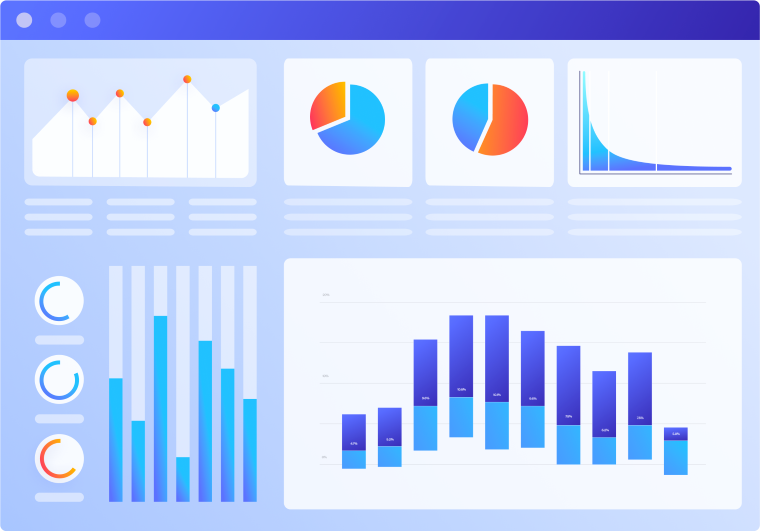
2. Focusing on the wrong KPIs
Some marketers become obsessed with improving their sites’ Domain Rating (DR) or Domain Authority (DA). These metrics are developed by third-party SEO companies Ahrefs and Moz, respectively, and reflect how strong your site is from a backlinking standpoint.
Clients are often surprised to hear that the Google algorithm does not take DA or DR into account when determining rankings. While many studies have demonstrated correlations between DA/DR and search performance, it’s better to focus on metrics that have direct implications for your bottom line–metrics like keyword rankings, traffic, and conversions.
To draw an analogy from the basketball world, it’s the same as using a team’s win rate as an absolute measure of success. Of course, having lots of wins is nice, but at the end of the day, the goal is to win championships. (Remember the 2015-2016 Golden State Warriors team that won a record-breaking 73 games in the regular season, only to lose to the Cleveland Cavaliers in the NBA Finals?)
3. Building backlinks for referral traffic
Link building is the practice of obtaining backlinks to your site from other technically strong sites on the web. Backlinks are indisputably a major ranking signal, yet many companies devote resources to creating quality content and then cross their fingers, hoping that this content will attract links naturally.
Others might hire a PR agency to achieve backlink goals. Unfortunately, most PR agencies build links for referral traffic and not SEO because they’re nofollow. Not to say that PR links aren’t worthwhile (they certainly can be), but if your goal is to rank specific pages for specific keywords, PR link building is typically insufficient.
As SEO link builders, our goal is to get the algorithm to recognize your content as authoritative so you can be rewarded with improvements in rankings for important keywords.
Backlinks are most effective when they’re placed in content that’s relevant to the target keyword. For example, if your SaaS platform helps businesses manage marketing content, it’s best to have your site’s backlink contained in a blog post about martech, not one about, say, sports. There are many other factors that should be considered when building backlinks and we’ve got you covered here.
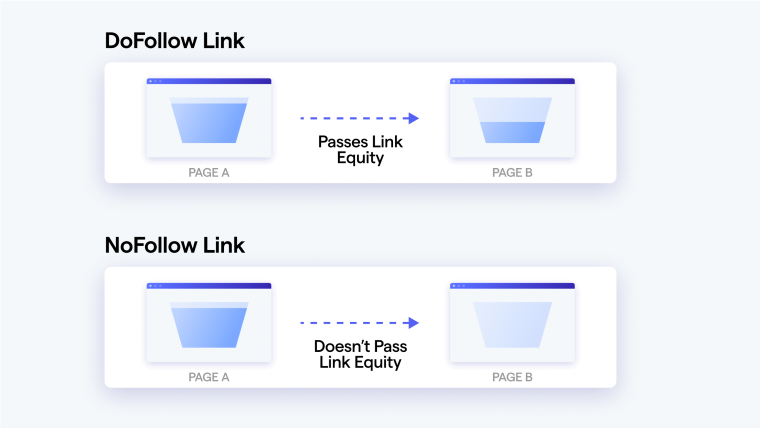
4. Poor content structure
SEO best practices for content structure are distinct from editorial practices. For example, one common error is to create a single page that discusses all of the valuable features of a product.
Let’s say you offer an accounting platform that includes an inventory management capability. If someone searches for “inventory management”, it’s highly unlikely that your platform page listing all of the different features (e.g., inventory management, reporting & analysis, expense tracking) would rank for that search term.
Instead, having a dedicated page that focuses on the “inventory management” feature exclusively will give you the best shot at ranking for that term.
Your platform should still briefly touch on the inventory management feature, but the dedicated page will provide more in-depth coverage.
5. Over-valuing the home page
While the home page is often viewed as the most important page on a website, home pages have become less valuable as the algorithm increasingly favors inner pages for most keywords.
Moreover, inner pages tend to contain more detailed information, which helps convince visitors that your product is right for them.
Home pages usually attract lots of traffic from searches for your brand name. And while they tend to be the strongest page on a site from a backlinking standpoint, focusing on more specific pages is usually the best course of action if your goal is to rank for more than just branded keywords.
6. Losing sight of the ultimate goal: conversions!
It’s easy to get caught up in tracking daily fluctuations with your SEO performance. Observing improvements in total number of keywords and organic search traffic is exciting, but at the end of the day the goal is to get qualified leads to convert. After all, stakeholders want to see a return on their investment.
This is what separates the good SEO practitioners from the great ones. When we speak with clients, we always emphasize our ultimate goal is to increase conversions, not just traffic.
Here at Linkflow, we think of conversions as our north star for SEO. Every decision should be made with them in mind.
7. The Trojan Horse strategy
When you’re introducing a brand new solution to the market, users haven’t heard of it and therefore, they aren’t searching for it. So, what to do?
For clients in this situation, a strategy we often recommend is what we’ve coined the Trojan horse strategy (no–not the virus!). Essentially, you can attract visitors to your site by using a highly searched, relevant keyword. Once they’re on your site, you can introduce them to your unique solution.
While at first this may feel like a bait and switch strategy, it’s important to remember that your goal is to help searchers answer a query. If you’re able to give them the information they’re looking for and capitalize on that as an opportunity to make a sale, it’s a win-win.
8. Using industry jargon that no one searches for
It’s natural to want to use industry jargon throughout your site’s content. However, if your audience doesn’t use those terms, you could be missing out on valuable traffic. For example, more people search for “jobs” than ”employment opportunities.”
By optimizing for the keywords people are actually searching for, you’ll have the best chance of capturing the most relevant traffic.
This can be a challenging proposition for non-SEO marketing stakeholders to accept, out of fear of seeming less “buttoned up.”
However, we’re in the business of driving qualified traffic to your site. If no one’s finding your content, the type of language you use is moot!
SaaS SEO Strategy: A Framework
We’ve spent some time discussing common pitfalls to avoid when building out an SEO strategy for SaaS, a.k.a. things you shouldn’t do. So, what should you do?
Here, we’ll outline a framework for developing your SaaS site’s SEO strategy:
1. Determine your “money” keywords
Keyword research is the foundation of SEO. The quality of the traffic you drive to your site is a direct function of the keywords your site is optimized for.
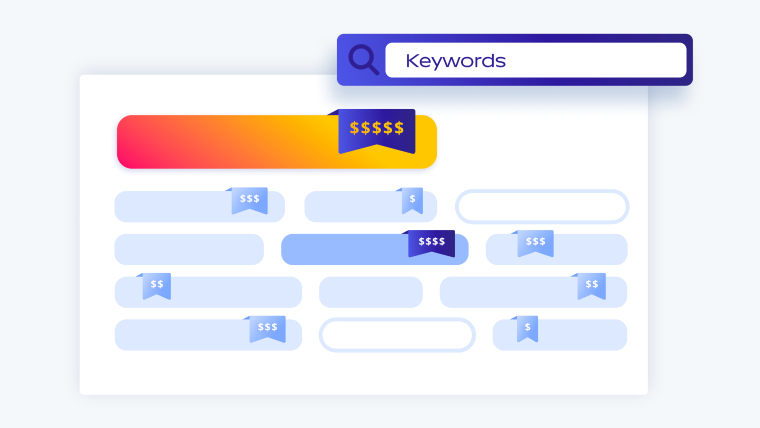
There are several popular keyword research tools out there–some of the most popular are Ahrefs, SEMRush, and Moz.
These tools can provide you with information about monthly search volumes and keyword difficulty. However, search intent is perhaps the most important factor when assessing potential keywords.
A quick refresher on the marketing funnel and its relationship with search intent:
Bottom of funnel
When a prospect is at the bottom of the funnel, they know exactly who and what they’re looking for (e.g., “Freshbooks invoicing software”). It’s usually easy to rank for your own branded keywords, so we won’t focus on this keyword type.
Exact keywords (a.k.a. Middle of funnel)
When doing keyword research for a SaaS client, the first thing we do is look at keywords containing the words “software”, “solutions”, “platform”, and “tools”. People who are searching for these terms have strong intent. In other words, they are actively searching for a product/service like yours, the only question is: will they go with you or a competitor?
Because these keywords are so incredibly valuable, they tend to be the most difficult to rank for. Whether you should pursue these keywords depends on your unique circumstances, but whenever possible, we advise clients to prioritize these keywords because the quality of visits is simply unmatched.
Top of funnel
Whether money keywords are just too competitive or you’ve already conquered them, top of funnel keywords can be a fruitful source of qualified traffic. Although users searching for these keywords haven’t clearly indicated a desire to make a purchase, top of funnel keywords tend to be highly searched. So, getting even a small fraction of those visits can be game-changing.
For example, let’s say your platform helps businesses manage the talent recruitment process. You could create content on the topic of “employee onboarding checklist” to attract HR professionals to your site (just make sure to include opportunities for users to convert throughout this content).
One special type of top of funnel keyword is what we call problem-oriented keywords.
What problems do your customers face that your solution can fix? Chances are they’re turning to Google to solve them.
Examples of problem-oriented keywords:
- “How to convert a PDF file into a Word file”
- “Fixing 404 errors”
- “My projects are always over budget”
An added benefit of problem-oriented keywords is they can help you position your brand as an authority when it comes to those topics. Some SaaS brands even choose to build knowledge bases by producing content that outlines solutions to their audience’s most common problems.
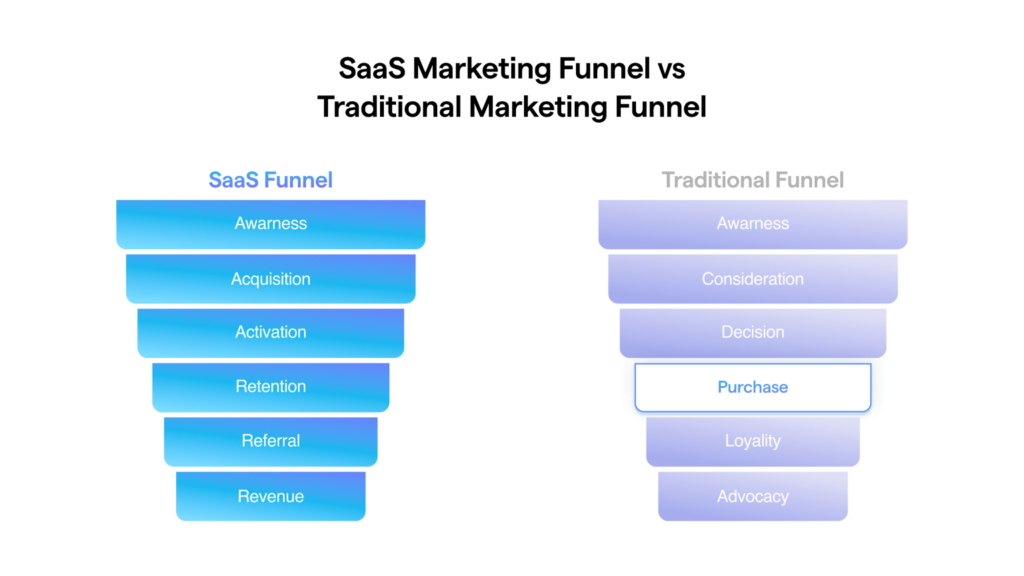
2. Brainstorm a User–and SEO–Friendly Content Structure
The most effective site structure that we recommend for SaaS companies is:
- A platform page: This page should provide a comprehensive overview of your product. In most cases, the goal is to push visitors who have accessed the site via other pages (such as blog posts) to this page.
- Solutions pages: These pages address the various use cases for your solution. Talent recruitment, onboarding management, offboarding solutions. While you might feel tempted to list all of the solutions on the platform page and call it a day, having dedicated pages for each solution will give you the best chance of showing up in search for keywords specific to that solution.
- Features pages: Each page will describe that feature in detail, and encourage readers to move to the platform page.
- Industry pages: These pages will describe how your solution can be used in specific industries. Construction industry, SaaS industry, Investment banking
- Customer Persona: HR Manager, Recruiter, Compensation Analyst
- Blog: For top-of-funnel traffic. “Employee onboarding checklist”
A note on redundancy: As you’re producing these pages, it’ll sometimes feel like there’s lots of repetition between pieces of content. However, it’s important to remember that most users will not sit and read every page on your site.
Instead, they’ll probably search for a specific feature and land on your site’s feature page first. So, write each piece of content as if a user is being introduced to your product and brand for the first time (chances are, they are!).
3. Producing world-class content
We’ve all heard the phrase “content is king” but what does this actually mean?
World-class content does more than describe the different features of your product–it speaks to readers on an emotional level.
Moz refers to great content as 10x content: content that is ten times better than the next best alternative. The great thing about striving for 10x content is it forces you to take a look at the competition–What do they do well? What gaps can your content help fill?
We won’t spend too much time on content writing, but here are a few tips to keep in mind:
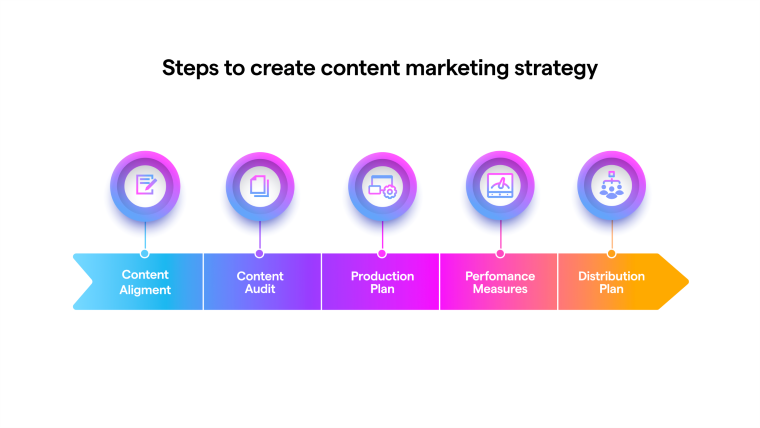
Appeal to emotions: Understanding and articulating the user’s pain point is key–by demonstrating empathy, users are more likely to trust the advice/analysis that follows.
Sales teams typically offer the best insight into your customer psyche since they speak with prospects regularly.
Speak in plain language: The days of writing content that sounds like a research paper are long gone. To keep users’ attention, write in a conversational tone.
A note on comprehensiveness: While long-form posts typically perform well in search, avoid writing “fluff” content for the sake of expanding word count. If you can convey your ideas in a short and sweet manner, no need to drag it out–your readers will appreciate it.
Make content dynamic: Save the walls of text for textbooks! It’s easier than ever to include engaging infographics and video content so users have options for how they consume the information on your site.
Listen to your audience: When your blog attracts a large audience, readers will naturally respond with feedback or questions. Consider adding their questions as FAQs to the page or using them as ideas for future blog posts.
Creating content is one of the most time-consuming tasks in SEO and can delay your start to ranking for important keywords. Significant advancements have been made in content production–AI tools are now available that can produce written content with just a few keystrokes. While the technology can’t yet replace a seasoned copywriting professional, it’s just a matter of time before it does.
Don’t have enough time or people to
produce the content you need?
We can help.
4. Connect your pages
There’s loads of content on the web about various white hat link building practices to get external backlinks (i.e., links from other websites), and this tends to overshadow the importance of internal linking.
Internal linking is one of the most underrated SEO tactics out there.

Internal linking is concerned with how the pages within your own site connect to one another. A quick overview:
Let’s say you build backlinks to your homepage (homepages usually have the most links anyway)–any page that the homepage links to will also benefit from those backlinks.
If your pages link to one another optimally, “link juice” can be spread across those pages.
The best thing about internal linking is: unlike external backlinks, you have complete control over how your pages link to one another.
One of the ways to do this is to include an internal link block within your content that allows users to navigate to other pages that are on the same level. For example, your features pages should all link to one another within the content.
While connecting your internal pages is important, be careful to avoid link bloat. One of the most common internal linking issues we see with clients is excessive links in the top nav or footer of a site. There is a critical point where too many links can overwhelm users.
In a presentation at MozCon, Alex Stein from Wayfair.com details how various experiments with link trimming resulted in significant increases in rankings, traffic, and conversions.
5. Don’t forget SERP Appearance
Ranking on page 1 is important, but it’s in vain if no one is clicking on your listing. An attractive SERP appearance can help users decide (in less than a second) whether they should click on your listing. Take a look at the top listings on the page–do they all look the same? In this case, it should be easy to differentiate your listing.
Some tips for a solid SERP appearance:
- Include the target keyword first in your title tag
- Include brand name last
- Vary capitalization
- Use descriptive, captivating language
- Make meta description compelling
- Include schema when appropriate
6. Technical SEO
The phrase “technical SEO” can strike fear in the hearts of even the most savvy SEOs.
Technical SEO refers to the area of SEO that focuses on “crawlability” of your site. It includes, but is not limited to:
- Site speed and Core Web Vitals
- Mobile friendliness
- Indexability
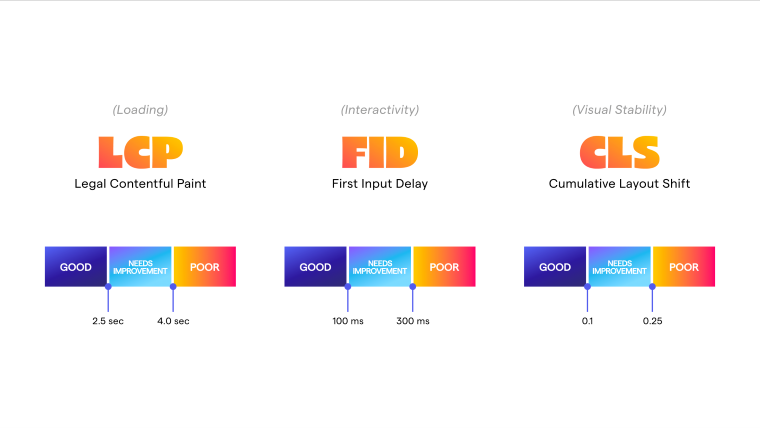
Although it’s easy to lose sight of the reason for technical SEO, these best practices are meant to improve user experience. Users don’t want to wait 5 seconds for a page to load, and if they click a link that takes them to an error page, they lose trust in the site.
Occasionally, we’ll work with a client that has severe site speed issues. In these rare cases, significant time will need to be devoted to remedy these technical SEO issues before we can address content optimization or link building.
While we don’t want to understate the importance of technical SEO, in most cases, we work with clients who are devoting far too much time and energy to issues that will not meaningfully improve their search performance–for example, you don’t need to worry about improving site speed by .00001 seconds when your content doesn’t contain any of the keywords you want to rank for!
Takeaway: Prioritize critical technical SEO issues and address the remainder after you’re done with steps #1-5.
7. Conversion rate optimization (CRO)
First, it’s important to determine what action they’re most likely to perform based on where they are in the funnel.
Searchers at the bottom of the funnel are typically qualified leads who can schedule a call right away or book a demo, whereas folks who are searching for problem-oriented keywords might be more likely to download a whitepaper.
That is, bottom of funnel content should have plenty of buttons encouraging users to schedule a call, whereas top of funnel content should have a lead magnet and email capture form.
It’s always puzzling when we review a site with just one tiny button nestled in the upper right hand corner that directs the user to convert (download a PDF, schedule a discovery call, fill out a form).
Make this part foolproof: tell users exactly what you want them to do, and tell them often.
A few other CRO tips:
- CTA button colors should heavily contrast the rest of the colors
- Use strong CTA language
- Make sure your top nav is sticky (i.e., it remains static as you scroll down the page)–this ensures that a CTA is always present, no matter where you are on the page
CRO specialists live and die by the mantra of A/B testing and it’s great to use data to make decisions about your site’s design. However, it’s easy to get in the weeds with CRO testing, so focus on driving traffic first before dedicating too much time to this at first.
8. Develop a link building strategy
Creating keyword optimized content without building links is like building a car from scratch but forgetting to fill the tank with gas. Link building is what helps search engines determine which content is authoritative. In a sea of untrustworthy content, links help search engines find the gems.
One of the most common ways to build links to your site is to publish guest blogs. Guest blogging is the process of creating content for other websites to publish on their sites. The main benefit of this practice is that in exchange for the free content (and traffic that comes with it), the recipient site will allow you to place a backlink within the content.
First, identify which pages on your site you’d like to prioritize for link building. While there’s no hard and fast rule to identify the most important keywords, take a holistic look at search intent, keyword difficulty, and search volume.
This can be challenging because there will always be tradeoffs:
By building links to pages with easy keywords, you can start to see traffic improvements relatively quickly, which sends positive ranking signals to search engines. However, by delaying builds to higher difficulty content, you run the risk of widening the gap between you and your competitors. Therefore, we recommend building links to a mix of both easy and difficult keywords.
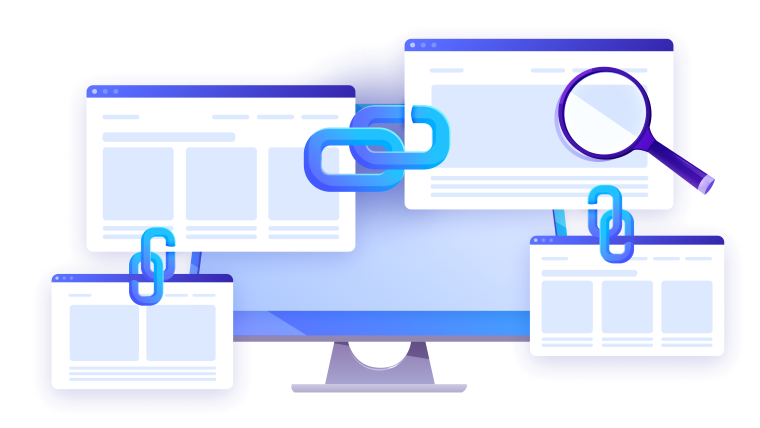
The next step is to create an outreach plan to ensure you regularly obtain backlinks. This includes:
- Identifying relevant, technically strong sites
- You need both relevance and authority for a site to be worth the effort of pitching. Here at Linkflow.ai, we look at a basket of metrics including Citation Flow, Trust Flow, as well as traffic patterns. Assessing link quality can be difficult because site quality is a subjective measure that takes into account a variety of factors. The most relevant sites are tech blogs, business news sites, etc.
- Researching the site to obtain the relevant contact person’s information
- You can reach out directly on LinkedIn or use tools like Hunter.io to learn how the target company structures email addresses ([email protected])
- Drafting a personalized email for each site that contains a pitch.
- Personalization is especially important. At Linkflow.ai, we regularly receive generic email outreach requests, and most of them get deleted.
- Creating optimized guest blogs that the site can feature
- This is one of the most time-consuming aspects of link building. You want to ensure that your guest blog is well-written and optimized for search traffic–make it easy for the site to accept!
- Determine anchor text
- Anchor text is the actual text that will contain the backlink to your site. Google uses the anchor text to understand what the linked page is about and it remains an important ranking signal. If enough of the anchor text pointing to your site contains the target keyword, Google will start to recognize you as the authority on that topic. When building links, you want to be careful not to over-optimize the anchor text.
Link building can be a time-consuming, complicated process.
If you’re limited on time, or unsure of how to build high quality backlinks the right way, we can help.
A note on paid link building: One of the most common objections to hiring a link building agency is that Google expressly forbids paid links.
This guideline is intended to discourage site owners from trying to game the system.
The truth is: even Fortune 500 companies build links. Working with a reputable SEO agency will help ensure your link profile is built in a safe and effective way.
Is the juice worth the squeeze?
SaaS marketers wonder whether the amount of time and money it takes to build a strong SEO foundation is worth the investment. And while we recognize our bias, our answer is a resounding YES!
One of the major benefits of SEO is that ranking well can pay dividends indefinitely, whereas pay-per-click (PPC) traffic stops as soon as your budget is exhausted.
A word of caution: SEO takes time. It can be months before you start to see traffic and rankings improvements for important keywords, and this can be difficult to stomach. But with a fine-tuned strategy and a little patience, you can dominate the organic search channel for your niche.
Final thoughts
SaaS SEO strategy requires a crystal clear understanding of your target audience, the unique problems they are trying to solve, and consideration of your company’s budgets, goals, and timeframe. By following the strategic framework outlined in this guide, you can set your site up for success with SEO.
If you’ve made it this far, and feel confident in implementing your own DIY SaaS SEO strategy, we wish you the best of luck with your site–you’ve got this! And if you want a team of trusted SEO professionals to do the heavy lifting for you, please schedule a call with us so we can help.

